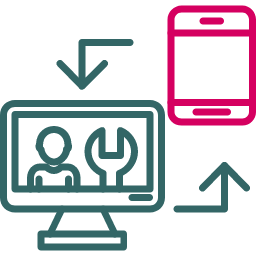With the world of technology being in a constant state of evolvement, Progressive Web Apps (PWAs) have emerged as a game-changer in the digital landscape. With their unique combination of the best features from both native apps and web applications, PWAs offer a new way to engage users and streamline the development process. As businesses and developers constantly thrive to provide innovative solutions to improve user experience and adapt to the ever-changing demands of the market, PWAs are becoming increasingly popular and relevant.
The purpose of this blog post is to provide an in-depth look at PWAs, examining what they are, their benefits and drawbacks, and how they compare to traditional desktop and mobile apps. We will also delve into the best use cases for PWAs and explore what the future holds for this exciting technology. So, let's dive in and explore the world of Progressive Web Apps together!
What are Progressive Web Apps (PWAs) and how did they start?
First off lets pin down the basics and start by discussing what progressive web apps are in the first place and how they came to be

What are PWAs?
Progressive Web Apps, or PWAs, are a hybrid between traditional web applications and native mobile apps. They are built using standard web technologies such as HTML, CSS, and JavaScript but can be accessed and used like native apps on mobile devices. PWAs provide a seamless and engaging user experience, allowing users to access the app without having to download and install it from an app store. They can run both online and offline and offer features like limited push notifications, home screen icons, and background updates, making them an attractive and practical solution for developers and businesses alike.
How did they start? - History and evolution
The concept of PWAs was first introduced by Google engineers Alex Russell and Frances Berriman in 2015. They recognized the potential for a new kind of web application that could bridge the gap between the convenience and performance of native apps and the accessibility and reach of web applications. Over the years, PWAs have gained significant attention and a surge in popularity, with many high-profile companies, such as Twitter, Starbucks, and Pinterest, adopting the technology to improve their user experience and reach a wider audience.
The evolution of PWAs has been driven by advancements in web technologies, including the introduction of Service Workers, which allow for background tasks and offline functionality, and Web App Manifests, which enable PWAs to be installed on a user's device and launched from the home screen. As web browsers and devices continue to improve, PWAs are becoming more capable, powerful, and relevant in today's digital landscape.
The Good: What are the benefits of PWAs?

Improved user experience
PWAs provide a seamless and engaging user experience that closely resembles native apps. They load quickly, respond instantly to user interactions, and can be accessed directly from the home screen, eliminating the need for users to search for and navigate to a web page. Additionally, PWAs can be designed to fit any screen size, ensuring a consistent and enjoyable experience across different devices.
Cost-effectiveness
Developing a PWA can be more cost-effective than creating separate native apps for multiple platforms. Since PWAs are built using standard web technologies, developers can maintain a single codebase and deploy the app across various platforms, reducing development and maintenance costs. Furthermore, businesses can save on app store fees and bypass the lengthy app store review process, allowing for faster updates and improvements.
Offline functionality and better performance
One of the key advantages of PWAs is their ability to work offline or in low-connectivity situations. Service Workers enable PWAs to cache content and serve it even when the user's device is not connected to the internet. This offline functionality, combined with the app's fast loading times and smooth performance, results in a more reliable and enjoyable user experience, regardless of network conditions.
Cross-platform compatibility
PWAs are designed to be cross-platform compatible, meaning they can run on any device with a modern web browser. This ensures that businesses can reach a wider audience without having to develop separate apps for different operating systems, such as iOS and Android. Moreover, PWAs can be easily shared through a simple URL, making it easy for users to discover and access the app.
Easier updates and maintenance
PWAs offer a streamlined update process compared to native apps. Since they are hosted on a web server, updates can be pushed instantly without requiring users to download and install new versions. This not only makes it easier for developers to roll out new features and bug fixes but also ensures that users always have access to the latest and most secure version of the app.
The Bad: What are the drawbacks of PWAs?

Limitations in native device features
Although PWAs have come a long way in terms of functionality, they still have some limitations when it comes to accessing native device features. While they can leverage many hardware capabilities, such as geolocation, camera, and to a certain extend push notifications, some advanced features like fingerprint authentication, Bluetooth, or NFC may not be fully supported or may have limited compatibility across different platforms and browsers.
Platform restrictions
While PWAs are designed to be cross-platform compatible, certain platforms and browsers may impose restrictions on their functionality. For example, iOS has historically been slower to adopt PWA features compared to Android, resulting in differences in performance and capabilities between the two operating systems. Additionally, not all web browsers offer the same level of support for PWA features, which may affect the app's performance and user experience on some devices.
Potential challenges with app store distribution
One of the main benefits of PWAs is the ability to bypass app stores, allowing for direct distribution through a URL. However, this can also be seen as a drawback, as businesses may miss out on the visibility and discoverability offered by app stores. While some app stores, such as the Google Play Store, now allow PWAs to be listed and distributed, others, like the Apple App Store, do not offer native support for PWAs, which may limit their reach and adoption among certain user segments.
How do PWAs compare to Traditional Desktop and Mobile Apps?

Development process
When it comes to the development process, PWAs have a clear advantage over traditional desktop and mobile apps. With PWAs, developers can build a single app that runs seamlessly across various platforms and devices, using a single codebase. This simplifies the development process and reduces the time and resources required to maintain multiple versions of an app. In contrast, traditional apps often require separate development for each platform, which can be time-consuming and expensive.
User engagement and retention
PWAs have the potential to improve user engagement and retention rates compared to traditional apps. Thanks to their web-based nature, PWAs can be easily shared and discovered through links, which can help drive user acquisition. Moreover, the offline functionality, fast loading times, and push notifications provided by PWAs can lead to better user experiences and increased engagement. On the other hand, traditional apps may face challenges in retaining users, as they must be downloaded and installed, and users may be hesitant to commit to the process.
Performance and compatibility
PWAs offer improved performance and compatibility compared to many traditional desktop and mobile apps. Since they are built on web technologies, PWAs can run on any device with a compatible browser, ensuring a consistent user experience across different platforms. Additionally, PWAs typically have better performance, as they leverage caching and other optimization techniques to deliver faster load times and smoother interactions. Traditional apps, on the other hand, may suffer from performance issues, especially when running on older devices or operating systems.
Distribution and discoverability
Distribution and discoverability can be both an advantage and a challenge for PWAs. Bypassing app stores allows for more direct distribution, but it may also mean missing out on the visibility offered by these platforms. Traditional apps, conversely, can benefit from the established user base and discoverability provided by app stores, though they may face more competition and stricter guidelines for approval and updates.
Who Benefits Most from using PWAs?

Small businesses and startups
PWAs can be an excellent choice for small businesses and startups, as they offer a cost-effective and efficient way to develop and maintain a web presence that works seamlessly across different devices. With lower development costs and a faster time to market, PWAs can help small businesses and startups compete with larger competitors and reach a wider audience.
E-commerce and retail
E-commerce and retail businesses can greatly benefit from PWAs, as they provide fast-loading, engaging, and user-friendly experiences that can help drive conversions and increase customer retention. PWAs can also offer offline functionality, enabling customers to browse products and add items to their carts even without an internet connection, which can be a significant advantage in the competitive e-commerce landscape.
Media and content platforms
PWAs can be an excellent choice for media and content platforms, as they provide a smooth, app-like experience that can keep users engaged and coming back for more. The offline functionality and push notifications offered by PWAs can also help drive user engagement and ensure that users stay updated with the latest content, even when they're not connected to the internet.
Enterprises
Enterprise businesses can benefit from PWAs by providing their employees with a consistent and efficient tool for accessing internal systems and resources. PWAs can be easily updated and maintained, ensuring that the latest features and security updates are available to users without the need for manual intervention. Additionally, PWAs can help streamline the development process, saving time and resources that can be redirected toward other strategic initiatives.
Organizations Requiring Internal Systems without App Store Distribution
Organizations that require an internal system but don't want to deal with app store distribution can benefit from PWAs. By bypassing app stores, organizations can more easily manage the distribution and updates of their internal systems. PWAs also offer a level of privacy and control that may not be possible with traditional apps, making them an ideal solution for organizations with strict security or compliance requirements.
What does the Future hold for PWAs?

Evolving web technologies
As web technologies continue to evolve and improve, PWAs are expected to become even more powerful and feature-rich. Advancements in areas like Web APIs, Service Workers, and Web Components will further enhance the capabilities of PWAs, making them an increasingly attractive option for businesses and developers. These developments will likely lead to PWAs becoming even more similar to native apps in terms of functionality and user experience, further blurring the line between the two.
Increased adoption by businesses and developers
The advantages offered by PWAs, such as cost-effectiveness, improved user experience, and cross-platform compatibility, are expected to drive increased adoption by businesses and developers. As more organizations recognize the benefits of PWAs, they will become an increasingly popular choice for both new projects and the migration of existing apps. This growth in adoption is likely to lead to a more diverse and robust ecosystem of PWAs, further strengthening their position in the market.
The potential impact on app stores and native app development
As PWAs gain traction and popularity, they could potentially disrupt the dominance of app stores and native app development. PWAs can be distributed directly by developers, bypassing app stores and their associated fees and restrictions. This flexibility in distribution could lead to a shift in the balance of power between app stores and developers, as well as an increased focus on web-based solutions for mobile and desktop applications. While native apps are unlikely to disappear altogether, PWAs may prompt developers to rethink their approach and consider whether a PWA is a more suitable solution for their specific needs.
Wrap Up
In conclusion, Progressive Web Apps have gained considerable momentum in the app development industry, thanks to their unique combination of benefits and versatility. As web technologies continue to advance, PWAs are poised to become an increasingly attractive option for businesses and developers looking to create engaging, high-performance applications that can be easily maintained and updated.
If you are planning a new app project or evaluating your existing app strategy, it's well worth considering the potential advantages of PWAs. By exploring this cutting-edge technology, you may discover that a PWA is the perfect fit for your needs, offering an optimal balance of user experience, cost-effectiveness, and cross-platform compatibility. Don't hesitate to research further and weigh the pros and cons of PWAs against traditional desktop and mobile apps to determine the best solution for your organization.
Are you ready to dive into the world of Progressive Web Apps?
Partner up with us to discover how a PWA can enhance your organizations experience
Icons by manshagraphics on freeicons.io
Share on social media